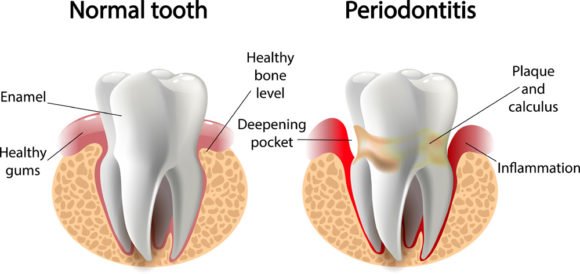Gum Disease or Periodontitis – Symptoms, Causes and Prevention
A very few know what is Periodontitis. It means “inflammation around the tooth” – it is a serious gum infection that begins with bacterial growth in your mouth and may end — if not properly treated — with tooth loss due to destruction of the tissue that surrounds your teeth. In most cases, periodontitis is preventable. It is usually caused by poor dental hygiene.
What’s the Difference Between Gingivitis and Periodontitis?
Gingivitis – gum inflammation usually precedes periodontitis (gum disease). However, it is important to know that not all gingivitis progresses to periodontitis.
In the early stage of gingivitis, bacteria in plaque build up, causing the gums to become inflamed and to easily bleed during tooth brushing. Although the gums may be irritated, the teeth are still firmly planted in their sockets. No irreversible bone or other tissue damage has occurred at this stage.
What are the Symptoms?
Periodontitis signs and symptoms can include:
- Inflamed (swollen) gums, gum swelling recurs
- Gums are bright red, sometimes purple
- Gums hurt when touched
- Gums recede, making teeth look longer
- Extra spaces appear between the teeth
- Pus may appear between the teeth and gums
- Bleeding when brushing teeth
- Bleeding when flossing
- Metallic taste in the mouth
- Halitosis(bad breath)
- Loose teeth
- The patient’s “bite” feels different because the teeth do not fit the same.
What factors cause Gum Disease ( Periodontitis)
The following factors are linked to a higher risk of periodontitis:
- Smoking- regular smokers are much more likely to develop gum problems. Smoking also undermines the effectiveness of treatments.
- Hormonal changes in females- puberty, pregnancy, and the menopause are moments in life when a female’s hormones undergo changes. Such changes raise the risk of developing gum diseases.
- Diabetes- patients who live with diabetes have a much higher incidence of gum disease than other individuals of the same age
- AIDS- people with AIDS have more gum diseases
- Cancer- cancer, and some cancer treatments can make gum diseases more of a problem
- Some drugs- some medications that reduce saliva are linked to gum disease risk.
- Genetics- some people are more genetically susceptible to gum diseases.
How Can Gum Disease Be Prevented?
- Gum disease can be reversed in nearly all cases when proper plaque control is practiced.
- Proper plaque control consists of professional cleanings at least twice a year and daily brushing and flossing.
- Brushing eliminates plaque from the surfaces of the teeth that can be reached.
- Flossing removes food particles and plaque from in between the teeth and under the gum line.
- Antibacterialmouth rinses can reduce bacteria that cause plaque and gum disease, according to the American Dental Association.
- If anyone in your family has gum disease, it may mean that you are at greater risk, as well. If you are more susceptible to gum disease, your dentist or periodontist may recommend more frequent check-ups, cleanings, and treatments to better manage the condition.
Sources : www.webmd.com, www.medicalnewstoday.com

